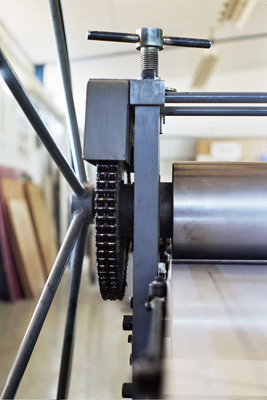The etching process
Producing an etching involves several stages and techniques. The artist or printer etches the picture onto a metal plate, fills in the cracks and depressions with paint, and lays the paper over the plate. A heavy press then bears down on the paper so that it comes in contact with the paint. The process produces etchings in one or several colors.
Stage 1: Etching
Etching on a metal plate, generally made of copper, iron or brass, may be done by several methods:
Drypoint etching. The artist etches directly on the metal plate, notching lines and depressions without cauterization.
Cauterizing the lines. The etching is created by working with a needle on a metal plate covered with a layer of wax ground, resistant to acid. The act of etching removes the ground and exposes the desired areas on the plate. The plate is then dipped in an acid bath which cauterizes the exposed areas, thereby creating grooves. The grooves are later filled with color.
Aquatint. This technique enables creating areas of color ranging from light to dark shades. Rosin powder is spread over the plate, and a warming process causes each particle to withstand the effect of the acid. Asphaltum (liquid asphalt) is then poured over the plate, followed by a gradually applied acid bath. This technique is generally combined with needle etching to create both lines and open spaces.
Open bite. Cauterization is done by applying concentrated acid directly to specific areas of the metal plate.
Stage 2: Applying the color
After the etching and cauterization process is completed, color is spread over the entire metal plate and the plate is then wiped, so that the color remains only in the etched or cauterized areas.
Stage 3: Printing
The paper that is selected for printing is laid on the plate and is held in place by a heavy press that forces the paper to come into contact with the colored areas and grooves. A print with several colors requires preparing a separate plate for each color and printing the colors on the paper one at a time. Sometimes the artist applies color directly on the printed paper thereafter, which enhances the value of the print.

The artist signs each print by hand, signifying that the etching is an original, and also numbers the print. Once all the prints in the edition have been produced, the plate is destroyed so that no further copies may be made.